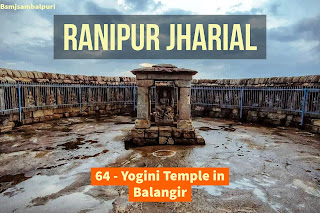Yogini temples were built in the states of Odisha, Madhya Pradesh, Uttar Pradesh, etc. from the eighth to the twelfth century. There are two 64 yogini temples present in Odisha. One at Hirapur and another at Ranipur Jharial in Titilagarh sub-division of Balangir district.
According to Brihatsamhita, the construction of the Yogini Shrine is on the rise in the sixth century. According to the source and Various inscriptions, there are fourteen temples where yoginis are worshiped. Of these, only Khajuraho, Jabalpur, Hirapur, Ranipur Jharial, and Vedaghat temples are known.
Name of 64 -Yoginis
The idols of the yoginis are usually found to be naked. The symbols of the feminine power express the feelings of anger, passion, happiness, sorrow, etc. The identity of these sixty yogini sitting at the Yogini Peetha is their name in the Kalikapurana. These are (1) Narayani, (2) Gauri, (3) Shakambari, (4) Bhima, (5) Raktadantika, (6) Bhramari, (7) Parvati, (8) Durga, (9) Katyayani, (10) Mahadevi, (11) Chandraghantha, (12) Mahavidya, (13) Mahatapa, (14) Sabitri, (15) Bramhabadini, (16) Bhadrakali, (17) Vishalakshi, (18) Krushnapingula, (19) Rudrani, (20) Agnijwala, (21) Roudamukhi, (22) Kalaratri, (23) Tapaswini, (24) Meghaskana, (25) Sahasakshi, (26) Bishnumaya, (27) Jalodari, (28) Mahodari, (29) Muktakesi, (30) Ghorarupa, (31) Mahabala, (32) Shruti, (33) Smruti, (34) Dhruti, (35) Tusti, (36) Pusti, (37) Medha, (38) Vidya, (39) Lakshmi, (40) Saraswati, (41) Aparnra, (42) Ambika, (43) Yogini, (44) Dakini, (45) Shakini, (46) Hakini, (47) Lakini, (48) Tradadeshwari, (49) Mahasasthi, (50) Sarvamangala, (51) Lajja, (52) Kaushiki, (53) Bramhani, (54) Maheshwari, (55) Kaumari, (56) Baishnavi, (57) Aindri, (58) Narasinghi, (59) Barahi, (60) Chamunda, (61) Shabaduti, (62) Vishnuduti, (63) Chandika, (64) Matruka.
Ranipur Jharial History and Distance
Ranipur Jharial is located at a 110 km distance from the Balangir district headquarters sub-division. It is the place for the famous 64 Yogani Peetha. Here 64 yoginis' small temples are there in a circular way and Bramha is the center. The Indralath Temple and the Somnath Temple are the other attractions here. It is believed that these temples are built in the ninth century by the Somavanshi kings, and some scholars referred to it from the "third-fourth century". Ranipur Jharial is also known as Somtirtha.
64 Yogini temples of Ranipur-Jharial are built on a circle on the hill floor. There are no pearls or sculptures on the outside. There are also sixty-four yoginis located in a circular fence like Hirapur. The yoginis temple is completely different in size, shape, and tradition from the other Hindu temples. It is circular in shape and has no roof on the top. In Ranipur Jharial there are also other temples along with the Yogini temples. It is said that there were once a hundred and twenty temples here. Meanwhile, the temples of the Indralath Temple and the Somnath Temple which was built on burnt soil bricks are still exist. It is believed, from the name Ranigudi or Ranipur (Queen's palace), the name Ranipur Jharial is taken.
Sixty-four yoginis names vary from place to place, but it is widely believed that the same number of yoginis were born to eight mothers. Ashtmatrika has given birth to eight Yogini each. According to ancient sources, the seven mothers gave birth to yoginis. Saptamatrika or Satabahani is still worshiped in some places in Odisha.
In 1874, researcher J.D. Begalar came here and wrote a research paper on the place. During the excavations of the state archeology department in 1975-76, a Buddhist seal was found here. Devotees, historians, and travelers are coming here. Poets, writers, craftsmen, researchers, and beauty lovers are anxious to spend the night. But there is no such thing as a place to stay. Even with government bungalows, it doesn’t work. The Department of Archeology of the Government of India is responsible for the maintenance of the pace. It is also believed that the Yoginis roam during the nighttime, so people don't spend the night time here.
The Indralath Temple is one of the highlights of the Ranipur Jharial Peetha, whose height is more than sixty feet. It is said, Indradev worshiped Lord Shiva here. The main carvings of the temple and the main parts of Jagamohan are almost destroyed by time.

 BSMJSambalpuri
BSMJSambalpuri
